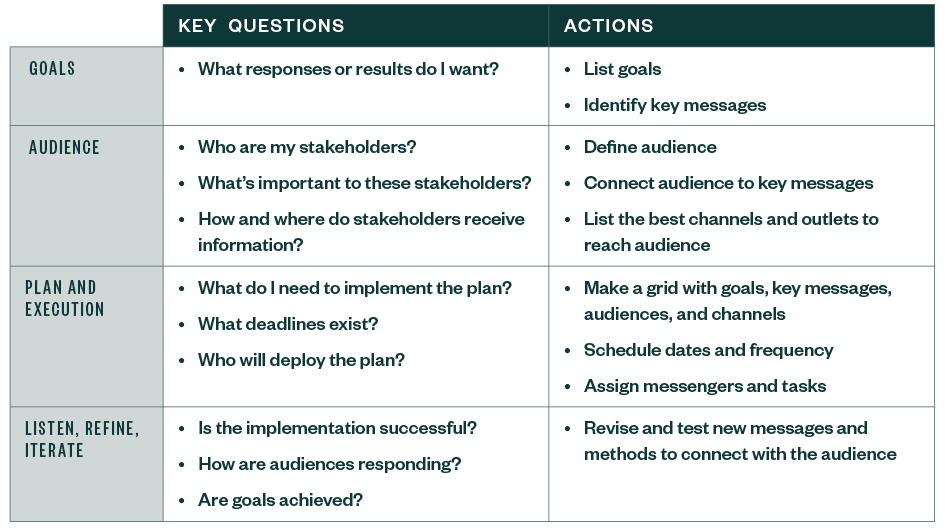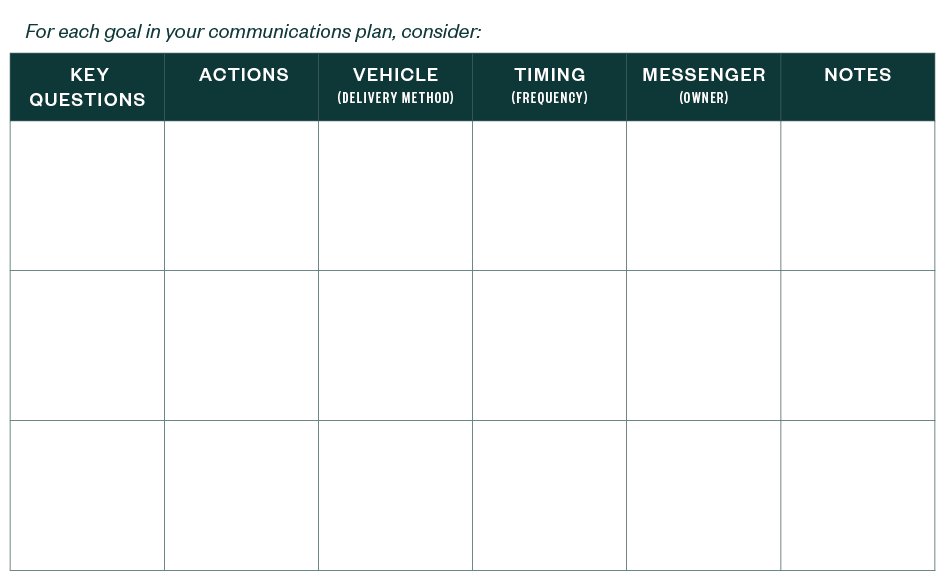
As your health care workforce navigates mounting COVID-19 cases and complexities around vaccine distribution, they risk the perils of burnout. In such challenging times, executive communications that establish a genuine connection with your workforce may be an executive’s most powerful tool to leading teams in troubled times.
Even if you can’t provide all the answers or have tough news to break, frequent, thoughtful communications can help reassure staff that you’re focused and committed to their well-being.
Below, we explore tips to build effective communication plans for your leadership.
Use a Framework to Build a Methodical Plan
Improving your connection to frontline teams means communicating more often and effectively. For busy executives, however, communications can be an afterthought or feel like too much work.
Bringing structure to your approach can help multiply its effectiveness, align and reinforce the entire leadership team around key messages, and save time and headaches over the life of the plan.
Following a simple framework can help you organize and launch an executive communications plan. This framework can be scaled up or down depending on the duration and complexity of the effort and the diversity of stakeholders you need to reach.

As you work your way through this framework, you’ll likely have numerous goals.
For each goal, think through your key messages; then, identify how you will get this information across, to whom, how, when, and by whom. Capture your answers in the following communications planning grid.

Framework Tips
The information you capture will be the foundation of your communications plan, which you can use to execute and monitor your messaging.
As you do so, keep the following communications practices top of mind.
Create a Clear Narrative
Knit your key messages together with a clear, compelling, cohesive story. This is the thread that connects your original goals to your ultimate outcome.
Enlist the Support of Your Leadership Teams
Gain upfront commitment from a unified leadership team to ensure cascading communication efforts in their respective areas—and support their efforts.
Deputize and delegate selected communication tasks to members of the communications team. Role model the importance of communications and encourage other leaders to help deliver and reinforce key messages.
Adapt the leadership team’s communication styles and norms as your project evolves.
Value and Integrate Feedback
Remember that you may have different stakeholders with varied, and even opposing, responses. Their interests are part of your evolving plan, so continuously solicit their involvement.
Test how your messages resonate with your diverse workforce, and then adjust as necessary.
Welcome Honest Dialogue
You may need to take extra steps to create so-called safe spaces to be sure you get honest and candid feedback—for instance, creating anonymous surveys or conducting listening sessions.
You’ll have greater long-term success if you earn trust and embrace open dialogue, however uncomfortable it may feel in the short term.
Embrace the Power of Flexibility
Role model active listening, flexibility, and willingness to change course. Be prepared to adjust your normal approach or step outside your comfort zone.
As you widen and deepen the feedback loop, you may hear back from teams and embrace new perspectives. Once you absorb reactions, you may wish to adjust messaging and vehicles to accommodate frontline perspectives.
Communications needs are as broad and unique as your organization’s circumstances. Whether they’re short-lived or complex and daunting, it will benefit you to follow a structured approach that can be scaled to meet your specific communications challenge.
Having this foundational framework will help you in every communications circumstance; but when your communications are unusually complex—for example, in times of crisis or emergency, or in a multiphased rollout—your planning will benefit from additional layers of structure that we will cover in our next article.
We’re Here to Help
To learn more about how to improve the reach of your executive communications or for guidance with strategy and operational consulting services to help with performance improvement, productivity, and engagement, contact your Moss Adams professional.